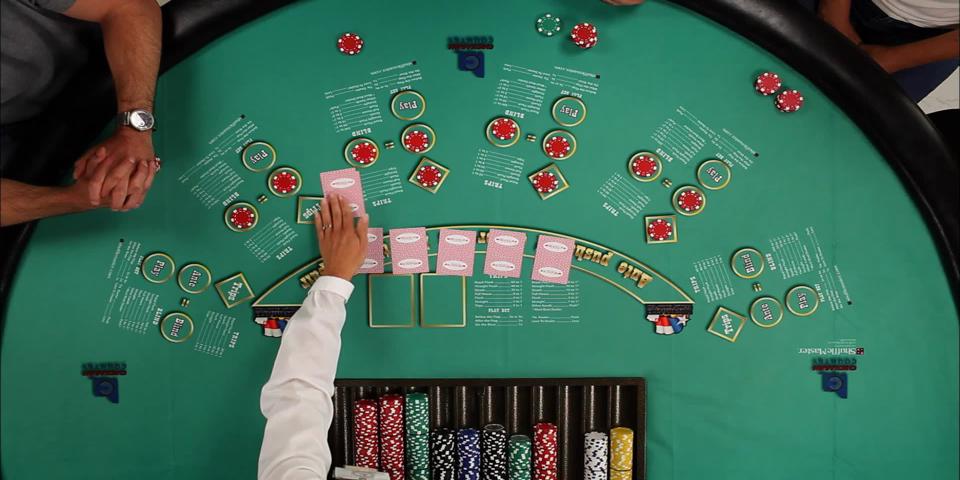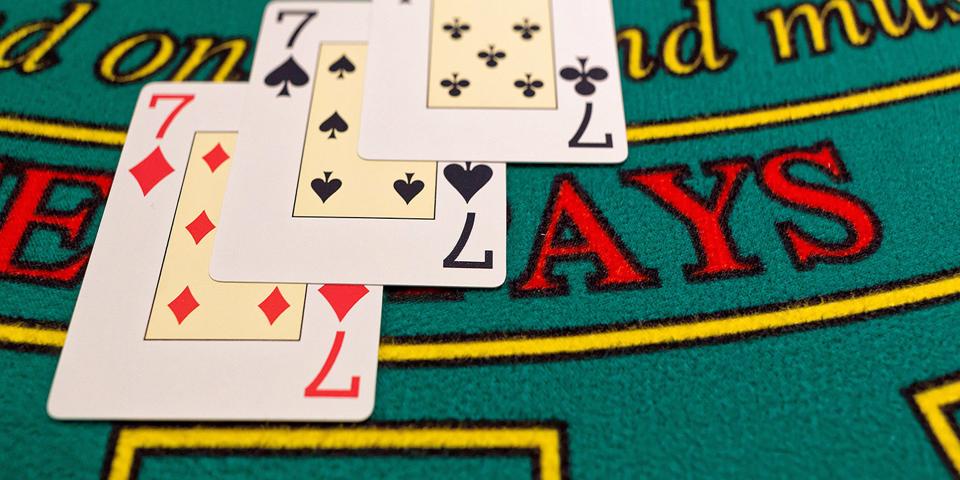
You’re probably familiar with Texas Hold’Em, but Ultimate Texas Hold’Em? That’s actually a completely different thing.
The game is simple – it’s a reinvented version of the classic game, but instead of players chancing their luck against each other, they’re pitched against the dealer. It brings the charm and play that we love from Texas Hold ‘Em and removes the most difficult part of the game – the other players.
The game starts off as you’d expect with a blind bet and an ante, but there’s also the option of a Trips side bet allowing players to acquire payouts when hands win or lose. When against the dealer, players are able to make one raise at any point and the earlier that this is made, the higher its value may be.
The game differs from other poker-based game as the ante remains in play even after the raise has been made as well as if the dealer does not open.
Quick history
Ultimate Texas Hold’Em is something of a recent phenomenon, developed by Roger Snow of Bally Gaming, Inc (formerly known as Shuffle Master).
The game, although most popular in US casinos, is played throughout the world, but is one of the most in-demand niche games found in Las Vegas casinos. Although the game was originally intended to be played on multiplayer electronic machines, it’s popularity soon pressed casinos to include a table game alternative.
How to play Ultimate Texas Hold’Em


Ultimate Texas Hold’Em can be picked up quickly and easily as there are only 3 options that players are required to choose from – the dealer does the rest.
The game begins with both dealer and player receiving two pocket cards in which players are permitted to look at their cards to choose one of the three options. They are required to either check, raise 3x the ante or raise 4x the ante, depending on how strong they feel their hand is. If a player chooses to raise, the action from their end finishes and the remaining community cards are dealt to reveal both player and dealer hands.
If the player checks, the first 3 community cards are dealt, giving the player the option to view any possible hand combinations and allowing a further decision to be made on the two options available. At this point, players can check once more or bet 2x the ante, finishing the action on their end. Betting finishes the action at the end of the player, allowing the dealer to reveal all community cards with hands revealed to identify the winner.
If the check option is chosen, the dealer reveals all 5 of the community cards (differing from Texas Hold ‘Em as the “turn” is skipped entirely for the “river”) giving two final options for the player. Given the knowledge of a hand, players are then given the option to either fold or bet 1x the ante.
Regardless of the decision made at this point, the dealer reveals their cards and proceeds to the “showdown.” A player must beat the dealer to win with the payout determined by the strength of their hand.
A full list of rules can be found below:
Ultimate Texas Hold’Em rules
If you’re looking for a bulletproof set of rules that you can rely on for playing the game in the states, you won’t need any more than 13 to get a full understanding of the game:
A standard 52-card deck is used to play the game.
A player must make an equal bet on both the ante and blind alongside the optional trips bet.
Two cards are dealt to both the dealer and player with the latter able to look at their cards.
The player is then able to decide whether or not to check, bet 3x the ante or bet 4x the ante.
The dealer is then to turn over the first 3 community cards if the player previously checked. If the player bets, all five community cards are turned over and the strongest hand wins.
If the player previously checked, they may either bet 2x the ante or check once more.
The dealer then turns over the final 2 community cards, completing the river.
If the player has checked twice they are given the option to either bet 1x the ante or fold, losing both the ante and blind bets.
At the end of the action, the player and dealer enter the “showdown” in which they build the best possible hand with the combination of their pocket cards and community cards.
The dealer must have at least a pair to open.
The following table displays how the blind, ante and play bets are scored according to who wins and whether or not the dealer is to open:
Winner
Dealer Opens
Blind
Ante
Play
Player
Yes
Win
Win
Win
Player
No
Win
Push
Win
Dealer
Yes
Lose
Lose
Lose
Dealer
No
Lose
Push
Lose
Tie
Yes or no
Push
Push
Push
A winning ante and play bet pays 1 to 1 and a winning blind bet pays according to the following paytable:
Player Hand
Payout
Royal flush
500 to 1
Straight flush
50 to 1
Four of a kind
10 to 1
Full house
3 to 1
Flush
3 to 2
Straight
1 to 1
Other
Push
The trips bet will pay in accordance with the following table regardless of the dealer’s hand:
Player Hand
Trips payout
Royal flush
50 to 1
Straight flush
40 to 1
Four of a kind
30 to 1
Full house
8 to 1
Flush
6 to 1
Straight
5 to 1
Trips
3 to 1
Although this version of the rules is widely accepted in the majority of the world, for players in New Zealand (specifically Auckland), there’s a small caveat in the way in which hands can be built.
Where traditionally any cards can be used to create the strongest hand possible, in the Auckland alternative both player and dealer are required to make their hand of both hole cards alongside 3 of the 5 community cards.
This, unsurprisingly, makes the game just a little tougher and proves a sticking point with some players.

Ultimate Texas Hold’Em strategy

When playing any hand in Ultimate Texas Hold‘Em, there are a total of 52 different outcomes that can be reached.
By splitting the different raises into 3 different categories (1x, 2x, and 4x the ante), it’s possible to see the payout, probability, and return for the different scenarios. This is the first step in creating any successful strategy – by getting your head around the numbers it’s possible to work out the very best way to act in any given situation.
As Ultimate Texas Hold’Em does not involve any mind games, bluffing or other (annoyingly good) players – it purely boils down to a numbers game, making things much easier to create a formula for the best plays.
Raise size: 4x Ante
First up, the 4x ante bet, and although there is the option to bet 3x, in the interest of simplicity we’re going to avoid the different bet sizing options and always opt for the larger of the two.
The table below shows the payouts, probability, and return for a number of different scenarios in the game:
Raise
Dealer
Qualifies
Player Hand
Winner
Pays
Probability
Return
4x
Yes
Less than straight
Player
5
0.131987
0.659933
4x
Yes
Straight
Player
6
0.008851
0.053105
4x
Yes
Flush
Player
6.5
0.008666
0.056332
4x
Yes
Full house
Player
8
0.010621
0.084966
4x
Yes
Four of a kind
Player
15
0.000827
0.012408
4x
Yes
Straight flush
Player
55
0.000065
0.003595
4x
Yes
Royal flush
Player
505
0.000021
0.010828
4x
No
Less than straight
Player
4
0.055972
0.223888
4x
No
Straight
Player
5
0.002927
0.014636
4x
No
Flush
Player
5.5
0.001829
0.010060
4x
No
Full house
Player
7
0.000000
0.000000
4x
No
Four of a kind
Player
14
0.000000
0.000000
4x
No
Straight flush
Player
54
0.000008
0.000446
4x
No
Royal flush
Player
504
0.000003
0.001638
4x
Push
0.010252
0.000000
4x
Yes
Dealer
-6
0.141353
-0.848116
4x
No
Dealer
-5
0.003691
-0.018454
Table: The payouts, probability, and return for a number of different scenarios when betting 4x the ante
When to bet the 4x

Looking at the numbers is all well and good, but what does that practically mean for the play?
Well, we can break down what players should do in each situation depending on what hole cards they’re holding before the first 3 community cards are dealt. In Ultimate Texas Hold’Em, this is where the big money comes in, so it pays to get it right and be cautious with the hands that you’re going all-in on.
A full list of the recommended 4x bets can be seen below:
Any hand that includes an A
Any hand with a K and 5 or better (any K and other suited cards)
Any hand with a Q and 8 or better (any Q and suited 6 or better)
Any hand with a J and 10 or better (any J and suited 8 or better)
Any pair of 3s or higher
That’s it, that’s all you need to know when it comes to the first round of betting. If your cards aren’t up to scratch, time to check and collect the first 3 community cards to see if there’s anything to help improve them.
Raise size: 2x Ante
When the second round of betting comes around, there are two options that players are able to choose – check or raise 2x the ante.
The table below shows the numbers (for those interested) and displays the payouts, probability, and return for a number of different scenarios.
Raise
Dealer Qualifies
Player Hand
Winner
Pays
Probability
Return
2x
Yes
Less than straight
Player
3
0.076036
0.228107
2x
Yes
Straight
Player
4
0.004785
0.019142
2x
Yes
Flush
Player
4.5
0.005487
0.024692
2x
Yes
Full house
Player
6
0.010405
0.062430
2x
Yes
Four of a kind
Player
13
0.000666
0.008664
2x
Yes
Straight flush
Player
53
0.000097
0.005153
2x
Yes
Royal flush
Player
503
0.000004
0.002031
2x
No
Less than straight
Player
2
0.038965
0.077930
2x
No
Straight
Player
3
0.001620
0.004860
2x
No
Flush
Player
3.5
0.001396
0.004885
2x
No
Full house
Player
5
0.000000
0.000000
2x
No
Four of a kind
Player
12
0.000000
0.000000
2x
No
Straight flush
Player
52
0.000013
0.000670
2x
No
Royal flush
Player
502
0.000000
0.000159
2x
Push
0.006889
0.000000
2x
Yes
Dealer
-4
0.066196
-0.264783
2x
No
Dealer
-3
0.000287
-0.000861
Table: The payouts, probability, and return for a number of different scenarios when betting 2x the ante
When to bet the 2x

Looking when to bet the 2x ante can be a little tricky because players must predict the dealer’s hand and compare the strength with their own without knowing the final 2 community cards.
It may be tricky, but it’s not impossible to create a strategy, and players should look to bet the 2x strategy when they’re seeing the following:
Any hand with two pair or better
Any hidden pair (bar pocket deuces)
Four to a flush including a 10 or better to that flush
If you’re unfamiliar with the “hidden pair” term, it’s super easy to understand. The hidden pair simply refers to any pair with at least one hole card used (thus hidden to the dealer).
Raise size: 1x Ante
Last up, the 1x ante bet on the final round of betting.
At this point, what your final hand is should be clear and you should have a pretty good idea of what the dealer could have too. You can see the numbers below for a variety of different scenarios if you’re interested.
Raise
Dealer Qualifies
Player Hand
Winner
Pays
Probability
Return
1x
Yes
Less than straight
Player
2
0.049437
0.098874
1x
Yes
Straight
Player
3
0.014205
0.042614
1x
Yes
Flush
Player
3.5
0.006866
0.024030
1x
Yes
Full house
Player
5
0.001557
0.007784
1x
Yes
Four of a kind
Player
12
0.000031
0.000371
1x
Yes
Straight flush
Player
52
0.000071
0.003669
1x
Yes
Royal flush
Player
502
0.000002
0.000760
1x
No
Less than straight
Player
1
0.025907
0.025907
1x
No
Straight
Player
2
0.004890
0.009781
1x
No
Flush
Player
2.5
0.001471
0.003677
1x
No
Full house
Player
4
0.000000
0.000000
1x
No
Four of a kind
Player
11
0.000000
0.000000
1x
No
Straight flush
Player
51
0.000010
0.000495
1x
No
Royal flush
Player
501
0.000000
0.000110
1x
Push
0.015041
0.000000
1x
Yes
Dealer
-3
0.097079
-0.291238
1x
No
Dealer
-2
0.001698
-0.003396
Table: The payouts, probability, and return for a number of different scenarios when betting 1x the ante
When to bet the 1x
It’s recommended to raise in the following situations; otherwise, it’s time to fold, cut your losses and move on to the next hand:
Any hidden pair of better
Less than 21 dealer outs beat you
The house edge

If we look at all three tables and add the return numbers, we can calculate the house edge which, in this case, stands around the 2.2% mark.
This means that for each $1 bet, the average player stands to lose around 2.2 cents, which doesn’t sound too great. However, when compared to other games of the same caliber, such as Caribbean stud poker of 5.2%, it suddenly doesn’t sound all that bad.
The takeaway
We’ve covered a quick history of the game, how it’s played, and some basic strategy surrounding Ultimate Texas Hold’Em – now it’s your turn to put it into practice.
By using the following strategy, playing by the rules, and treating your bankroll as an investment, you’ll find the best returns for your money.
When to bet the 4x
Any hand that includes an A
Any hand with a K and 5 or better (any K and other suited cards)
Any hand with a Q and 8 or better (any Q and suited 6 or better)
Any hand with a J and 10 or better (any J and suited 8 or better)
Any pair of 3s or higher
When to bet the 2x
Any hand with two pair or better
Any hidden pair (bar pocket deuces)
Four to a flush including a 10 or better to that flush
When to bet the 1x
Any hidden pair of better
Less than 21 dealer outs beat you


